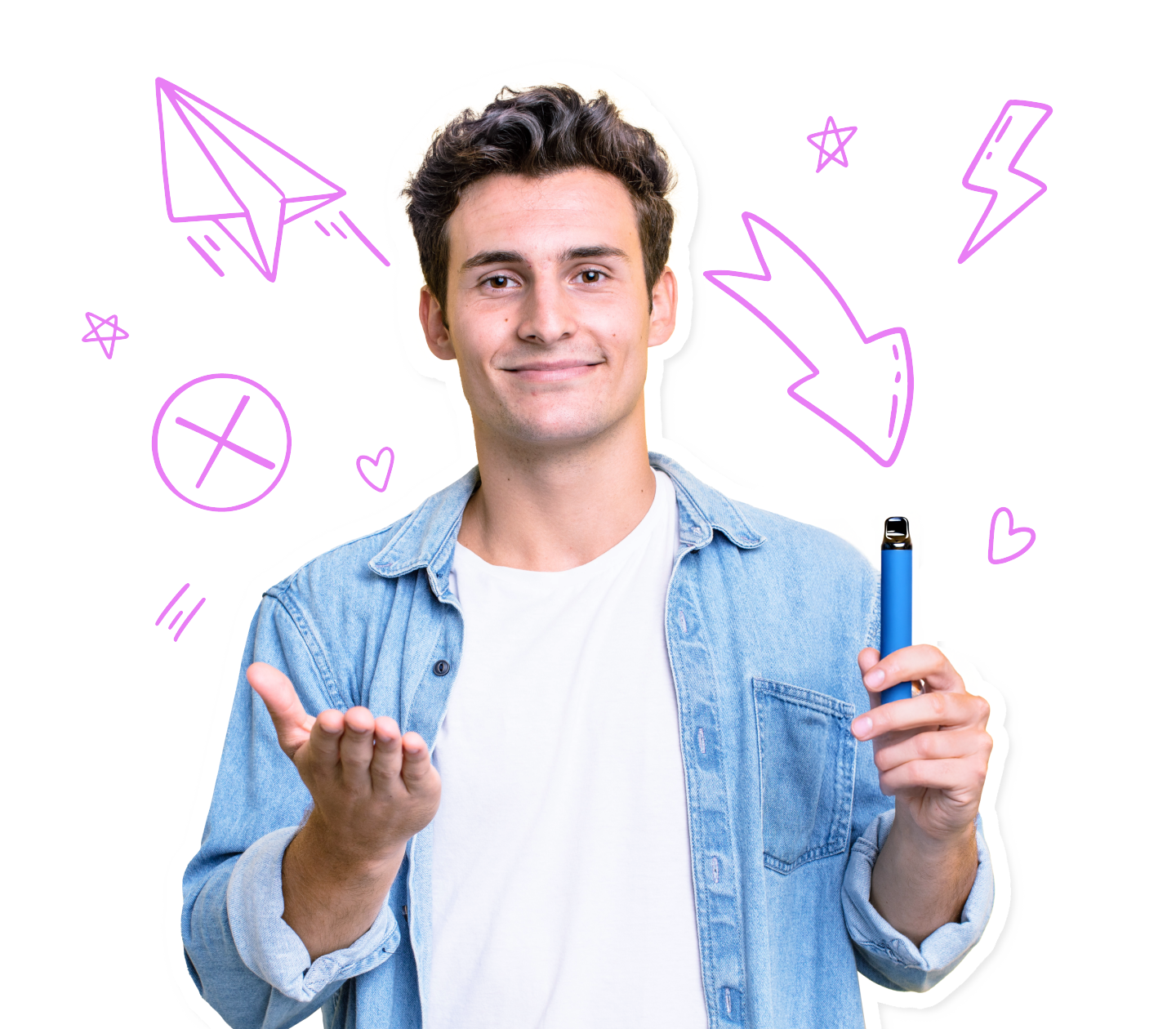
What you need to know about teen vaping
You are not alone – All our facilitators have been where you are now.
We are a World Health Organisation partner with over 20 years experience of helping vapers.
Vaping is safer than smoking right?
So, vaping might seem safer than smoking, but it’s still very bad for you!
In fact we don’t know all the health issues it can cause.
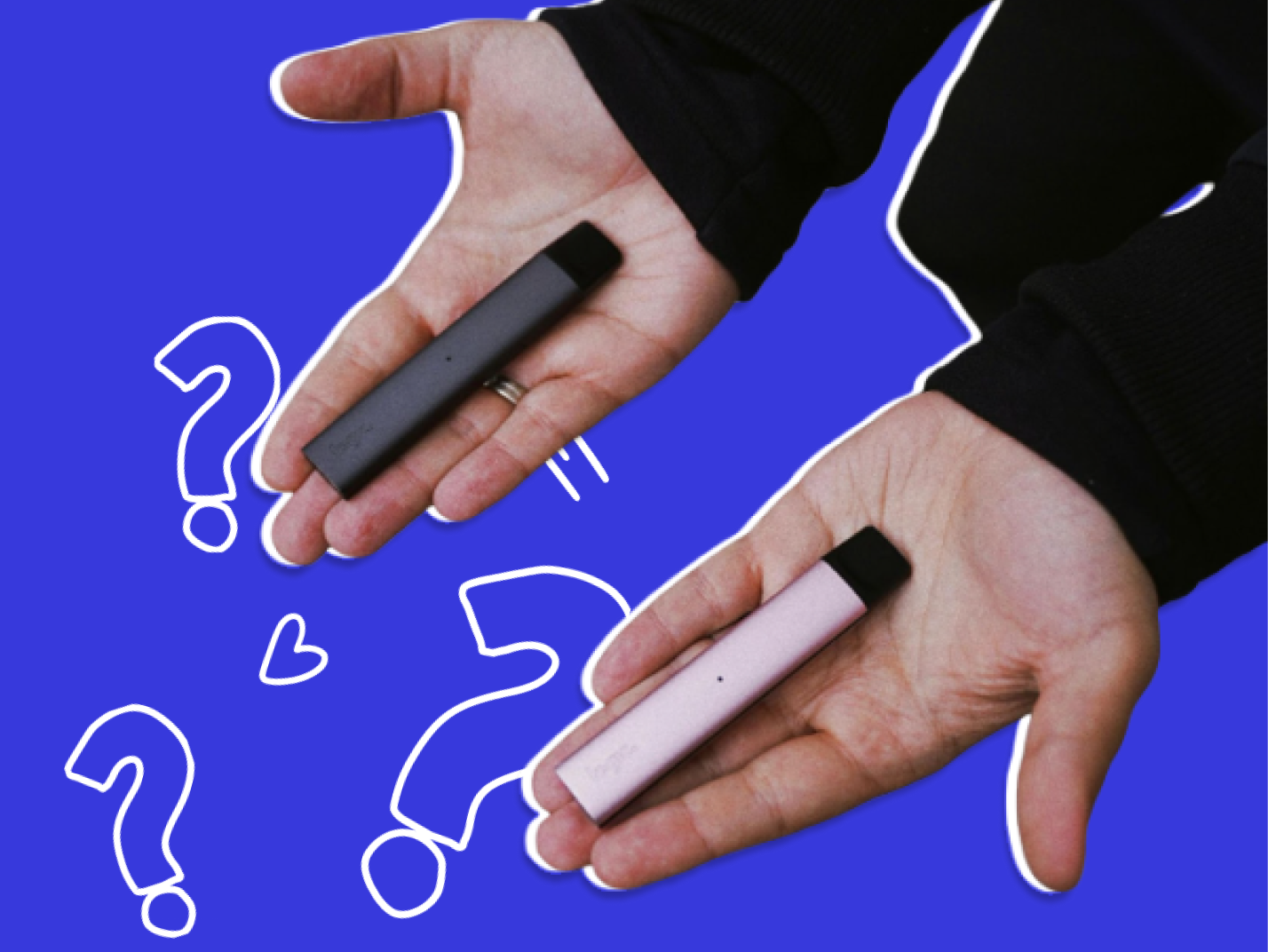
What is in vape juice?
Vaping liquid / juice contains around 80 different chemicals.
Not one of the four main ingredients in vapes (propylene glycol, vegetable glycerin, nicotine and any number of different flavourings) are designed to be breathed into your lungs.
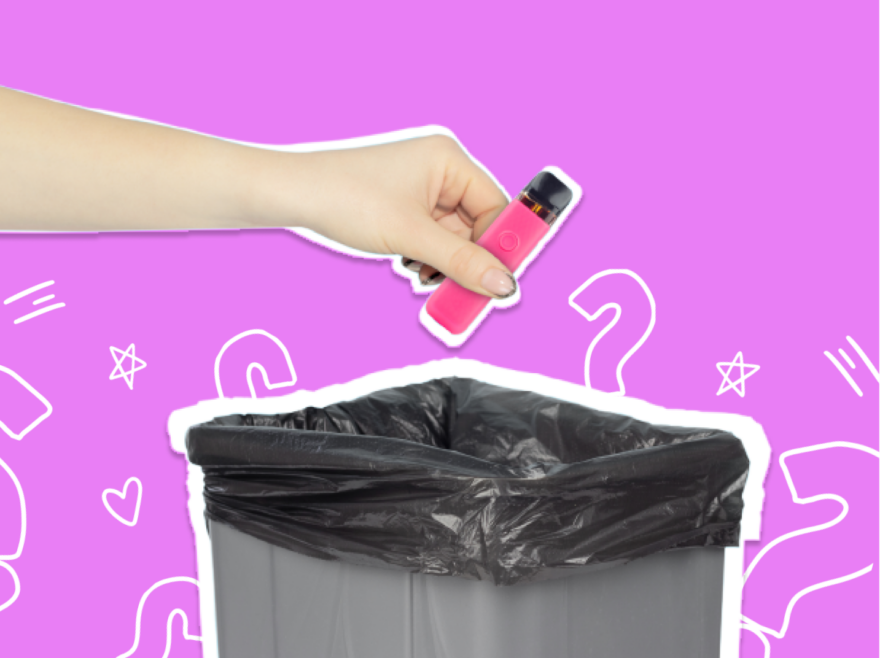
Nicotine-free vapes are safe?
Some vaping juices say they are nicotine-free but it turns out, a lot of times they actually sneak in some nicotine!
And that stuff is super addictive.
But nicotine is only one of the nasty chemicals that are in vape juice.
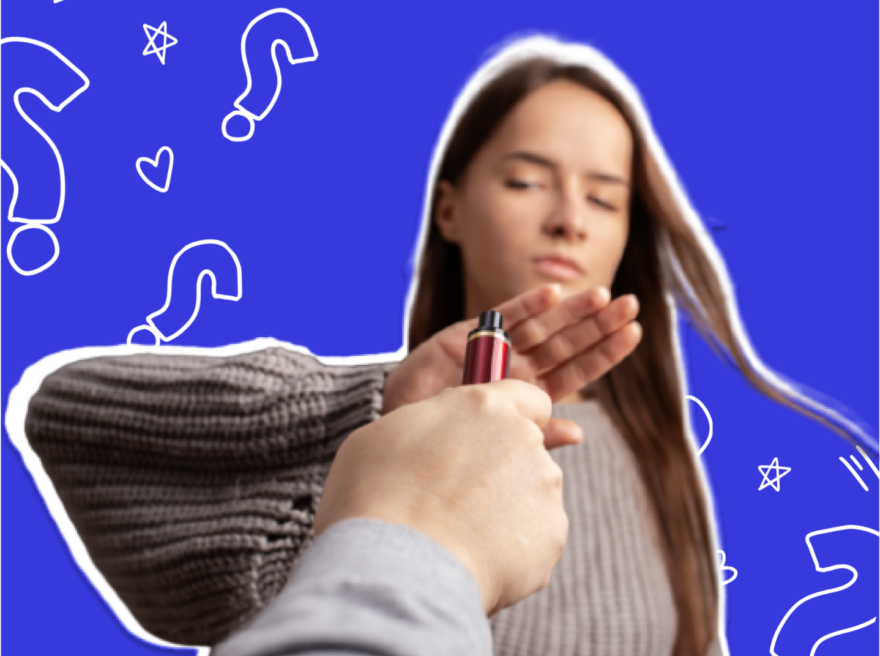
How can I be around my friends who vape when I quit?
So, if you want to hang out with a friend who vapes after you quit, you totally can! As long as you feel happy to be free – you’ll be fine.
Changing the way you think about vaping is key and you can do that with Allen Carr’s Easyway.

If I don’t vape I’ll be called boring and lose friends
Resisting peer pressure to vape can be tough, but it’s super important for your health and future.
When you rewire your brain and lose the feeling that you want to vape – there is no temptation to resist.

How do I help a friend that vapes?
Talking about addiction with your friends can be really tough, right?

Need help quitting?
The great news is that it doesn’t have to be hard to quit.
The Easyway method changes how you think about vaping and about quitting.
It has set tens of millions of people free, even some big-name celebs.
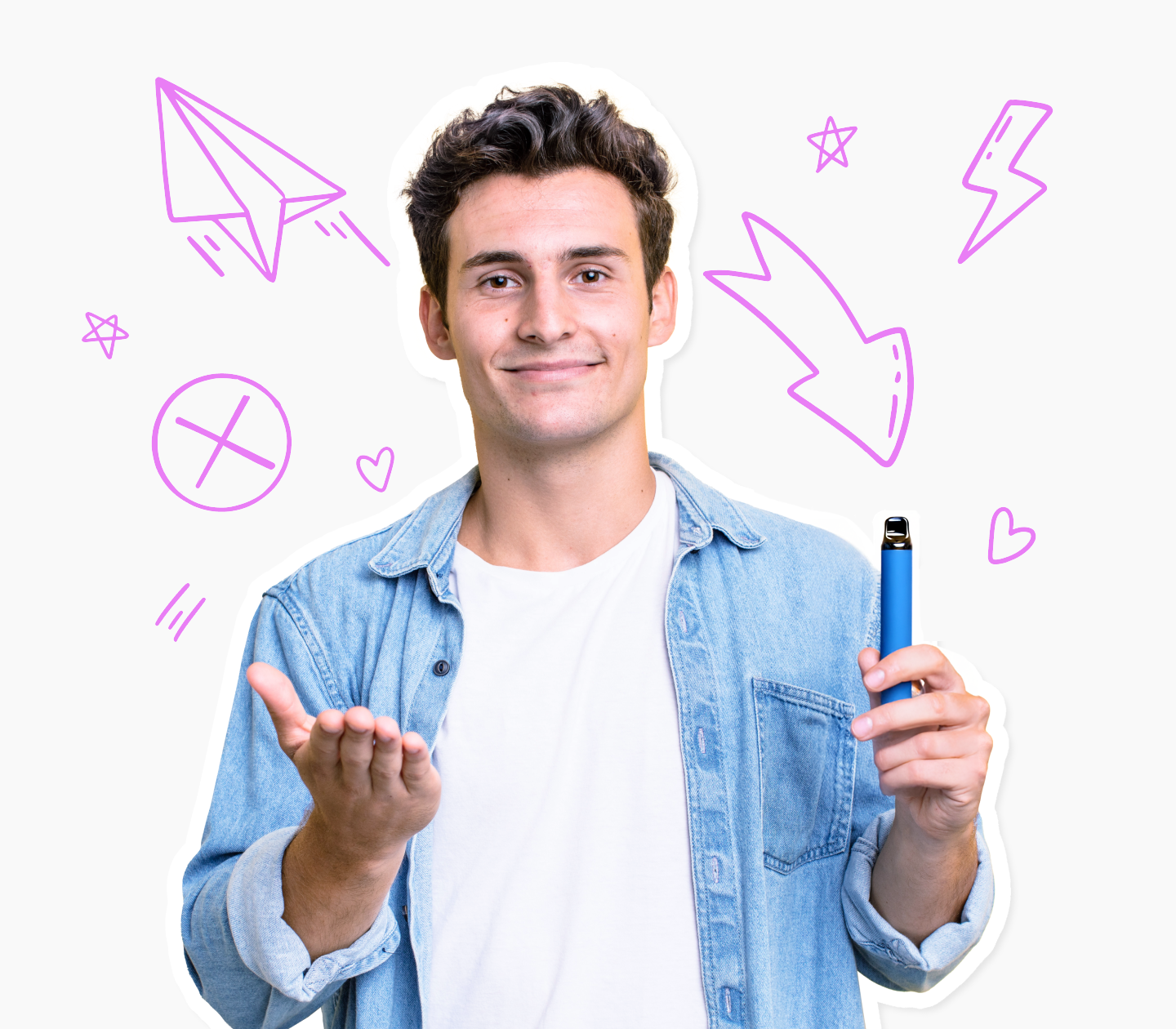
Celebrity testimonials
See what a few celebrities say about Allen Carr’s Easyway
A few client videos

Are nicotine free vapes safe?
Some vaping juices say they are nicotine free but it turns out, a lot of times they actually sneak in some nicotine!

How can I be around my friends who vape when I quit?
So, if you want to hang out with a friend who vapes after you quit, you totally can! As long as you feel happy to be free – you’ll be fine.

A page for school administrators, counsellors, and educators.

Learn how to identify signs that your teen is vaping and discover effective ways to help them.
References:
- Wang TW, Neff LJ, Park-Lee E, et al. E-cigarette Use Among Middle and High School Students — United States, 2020. Morbidity and Mortality Weekly Report, 2020;69. https://www.cdc.gov/mmwr/volumes/69/wr/mm6937e1.htm?s_cid=mm6937e1_w%20
- Samir S. Soneji, Kristin E. Knutzen, Andrea C. Villanti. Use of Flavored E-Cigarettes Among Adolescents, Young Adults, and Older Adults: Findings From the Population Assessment for Tobacco and Health Study. Public Health Reports, 2019; 003335491983096 DOI: 1177/0033354919830967 http://dx.doi.org/10.1177/0033354919830967
- Goniewicz ML, Gupta R, Lee YH, et al. Nicotine levels in electronic cigarette refill solutions: a comparative analysis of products from the United States, Korea, and Poland. Int J Drug Policy. 2015;26(6):583–588. https://pubmed.ncbi.nlm.nih.gov/25724267/
- The New England Journal of Medicine : Trends in Adolescent Vaping, 2017–2019 October 10, 2019 N Engl J Med 2019; 381:1490-1491 DOI: 10.1056/NEJMc1910739 https://www.nejm.org/doi/full/10.1056/NEJMc1910739 and University of Michigan Monitoring the Future vaping survey 2021 Richard Miech; Adam Leventhal; Lloyd Johnston Pediatrics October 2020, JAMA Pediatr. 2021;175(2):185-190; DOI: 10.1001/jamapediatrics.2020.5667, 2022 update
- Centres for Disease control and Prevention https://www.cdc.gov/tobacco/basic_information/e-cigarettes/Quick-Facts-on-the-Risks-of-E-cigarettes-for-Kids-Teens-and-Young-Adults.html
- Willett JG, Bennett M, Hair EC, et al Recognition, use and perceptions of JUUL among youth and young adults. Tobacco Control Published Online First: 18 April 2018. doi: 10.1136/tobaccocontrol-2018-054273 https://tobaccocontrol.bmj.com/content/28/1/115
- US Department of Health and Human Services. E-cigarette Use Among Youth and Young Adults: A Report of the Surgeon Generalpdf icon[PDF – 8.47MB]. Atlanta, GA: US Department of Health and Human Services, CDC; 2016. Accessed July 27, 2018. https://www.cdc.gov/tobacco/data_statistics/sgr/e-cigarettes/pdfs/2016_sgr_entire_report_508.pdf and US Department of Health and Human Services. E-cigarette Use Among Middle and High School Students 2020pdf icon[PDF – 8.47MB]. US Department of Health and Human Services, CDC; 2020. Weekly / September 18, 2020 / 69(37);1310–1312. https://www.cdc.gov/mmwr/volumes/69/wr/mm6937e1.htm?s_cid=mm6937e1_w
- July 2018 Gallup poll https://news.gallup.com/poll/237818/young-people-adopt-vaping-smoking-rate-plummets.aspx
- Parental Awareness of Youth Tobacco Use and the Role of Household Tobacco Rules in Use Prevention Tsu-Shuan Wu and Benjamin W. Chaffee Pediatrics October 2020, e20194034; DOI: https://doi.org/10.1542/peds.2019-4034 https://pediatrics.aappublications.org/content/early/2020/10/01/peds.2019-4034
- ASH Use of e-cigarettes among young people in Great Britain ASH-Factsheet-Youth-E-cigarette-Use-2019 , YouthEcig2020 , , Use-of-e-cigarettes-among-young-people-in-Great-Britain-2021, Use-of-e-cigarettes-among-young-people-in-Great-Britain-2022, https://ash.org.uk/uploads/Use-of-vapes-among-young-people-GB-2023-v2.pdf
- National Academies of Science, Engineering and Medicine Public Health Consequences of E-Cigarettes Report – https://www.nap.edu/resource/24952/012318ecigaretteConclusionsbyEvidence.pdf
- World Health Organisation Report on the Global Tobacco Epidemic 2021
- Raymond BH, Collette-Merrill K, Harrison RG, Jarvis S, Rasmussen RJ. The nicotine content of a sample of E-cigarette liquid manufactured in the United States. Journal of Addiction Medicine. 2018;12(2):127–131. https://pubmed.ncbi.nlm.nih.gov/29280749/
- NHS: Flavouring found in e-cigarettes linked to ‘popcorn lung’ https://www.nhs.uk/news/heart-and-lungs/flavouring-found-in-e-cigarettes-linked-to-popcorn-lung/
- A review of the comparative mammalian toxicity of ethylene glycol and propylene glycol J S LaKind 1, E A McKenna, R P Hubner, R G Tardiff Crit Rev Toxicol. 1999 Jul;29(4):331-65. doi: 10.1080/10408449991349230 https://pubmed.ncbi.nlm.nih.gov/10451263/
- A toxicological review of the propylene glycols J Fowles, M Banton, L Pottenger Crit Rev Toxicol 2013 Apr;43(4):363-90. doi: 10.3109/10408444.2013.792328 https://pubmed.ncbi.nlm.nih.gov/23656560/
- Propylene Glycol Toxicity in Children T. Lim, R. Poole, and N. Pageler, J Pediatr Pharmacol Therv.19(4); Oct-Dec 2014PMC4341412 https://www.ncbi.nlm.nih.gov/pmc/articles/PMC4341412/
- Fuoco, F.C.; Buonanno, G.; Stabile, L.; Vigo, P., “Influential parameters on particle concentration and size distribution in the mainstream of e-cigarettes,” Environmental Pollution 184: 523-529, January 2014.
https://www.sciencedirect.com/science/article/pii/S0269749113005307 - Grana, R; Benowitz, N; Glantz, S. “Background Paper on E-cigarettes,” Center for Tobacco Control Research and Education, University of California, San Francisco and WHO Collaborating Center on Tobacco Control. December 2013.
- Goniewicz, M.L.; Knysak, J.; Gawron, M.; Kosmider, L.; Sobczak, A.; Kurek, J.; Prokopowicz, A.; Jablonska-Czapla, M.; Rosik-Dulewska, C.; Havel, C.; Jacob, P.; Benowitz, N., “Levels of selected carcinogens and toxicants in vapor from electronic cigarettes,” Tobacco Control [Epub ahead of print], March 6, 2013
- Williams, M.; Villarreal, A.; Bozhilov, K.; Lin, S.; Talbot, P., PLoS ONE 8(3): e57987, March 20, 2013.
- Henderson, TR; Clark, CR; Marshall, TC; Hanson, RL; & Hobbs, CH. “Heat degradation studies of solar heat transfer fluids,” Solar Energy, 27, 121-128. 1981.
- Williams, M.; Villarreal, A.; Bozhilov, K.; Lin, S.; Talbot, P., “Metal and silicate particles including nanoparticles are present in electronic cigarette cartomizer fluid and aerosol,” PLoS ONE 8(3): e57987, March 20, 2013.
- Lerner, C.A.; Rutagarama, P.; Ahmad, T.; Sundar, I.K.; Elder, A.; Rahman, I., “Electronic cigarette aerosols and copper nanoparticles induce mitochondrial stress and promote DNA fragmentation in lung fibroblasts,” Biochemical and Biophysical Research Communications 477(4): 620-625, September 2, 2016.
- Guardian Newspaper https://www.theguardian.com/society/2023/mar/18/uk-health-expert-raises-alarm-at-epidemic-of-vaping-among-teenagers
- Elf bar nicotine levels Dr. Onkar Mudhar https://vaping360.com/learn/how-much-nicotine-is-in-a-elf-bar/#:~:text=Nicotine%20in%20a%20cigarette%20compared%20to%20Elf%20Bars,-A%20recent%20Tiktok&text=Dr.,equivalent%2020%20milligrams%20of%20nicotine.%E2%80%9D
- United states most popular vape flavor teenagers – Statista 2022
- U.S. Centers for Disease Control and Prevention and the U.S. Food and Drug Administration. National Youth Tobacco Survey 2022
- The Unexpected Harms of Vaping https://www.psychologytoday.com/us/blog/understanding-health-behaviors/202309/the-unexpected-harms-of-vaping
- Vaping and mental health: What’s the connection?https://blogs.bcm.edu/2021/05/06/vaping-and-mental-health-whats-the-connection/








